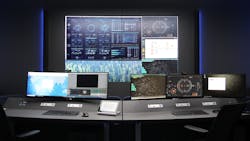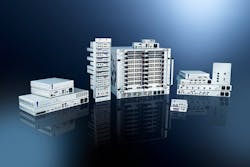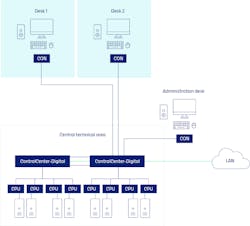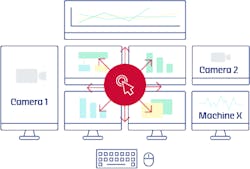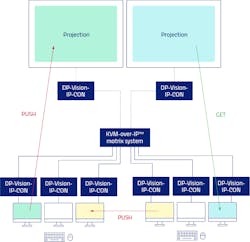Rethinking the control room by integrating modern KVM technology
As the digitalization of industrial process automation, or Industry 4.0, becomes more prevalent, forward-thinking organizations uniquely understand that their IT systems need to adapt to become more powerful and efficient. This digitalization trend creates much more data that needs to be managed, monitored and evaluated.
Intelligently networking and interlinking production operations with these IT systems requires a re-thinking of the control room by introducing the modern KVM technology.
What is KVM?
Keyboard, video and mouse, or KVM, refers to the respective interfaces of a computer. The technology has been used in industrial automation for decades already, but with the increased deployment of computer systems and IT-based processes, there is also an increased need for ideal system access and a more flexible system access. That is where cutting-edge technologies like KVM come into play.
A modern KVM system effectively separates man from machine. It removes computers from the workplace and stores those computers in a dedicated technical area free from the noise, clutter, heat and dust of a production floor or control room — and fully latency-free.
Secondly, and perhaps more importantly, is the increased flexibility advanced KVM provides. It allows an individual user to operate several processes simultaneously. Each workstation can consist of several screens — and each screen can show individual computer sources that an operator can survey and operate all at one time. KVM allows the right system availability at the right time. The user can easily switch between computers and handle complex consoles with many screens, but with just a single keyboard and mouse.
Modern KVM also integrates hybrid computer environments: physical servers on-site and cloud-based computing. Hybrid KVM systems are state-of-the-art. Organizations are unlikely to leave all their processes to the cloud. Some basic, and probably the most critical, processes are hosted onsite, while other aspects can be moved to the cloud. KVM allows them both to be readily accessed.
Also, with aspects for teleworking, newer KVM can achieve remote access from the outside. An organization may have core processes in the layout that they typically work on-premises, but for emergency access, KVM allows for remote administration.
In short, modern KVM systems are not limited to a finite set of computer targets or users such as with earlier iterations, or “desktop” KVM switches. Modern KVM can be expanded at any time with almost no limits.
Mitigating cybersecurity risks with KVM
Cybersecurity is an important aspect that KVM solutions allow to make installations more secure. Removing the computer from the desk is a core strategy for protecting its access. Data shows that most cyberattacks originate internally — either by human error or on purpose — as opposed to from the outside.
Externally, modern KVM systems allow an organization to achieve “network separation.” With different security classifications of the networks (one being dedicated networks where all the critical processes run and a separate network that may even have access to the public internet, which would make it more at-risk of an external attack), the risk of cyberattacks can be minimized. KVM systems provide the basis for flexible system access and help to harmonize computer technology across systems.
With KVM, users only access the computer interfaces. Several systems are accessible at the same time, but without a data connection between the systems. Organizations can separate critical internal applications in the data flow from external applications like web surfing or external video conferencing. For example, critical processes can be kept on the internal network and everything that is connected to the outside world can be kept separate.
KVM and a seamless interconnection
Modern KVM systems build the backbone of IT- and OT-supported processes in organizations. They provide an optimal basis for seamless interconnection of all used systems and seamless IT integration in industrial process automation.
Through today’s KVM technology, the signals from outsourced computers are provided in real time in the control room. KVM systems can ensure perfect system interoperability.
Control room operators have, at any time, the right system at hand and can run the desired switching commands. In short, KVM enables the visualization, control and monitoring of complex processes and creates the interconnection of different applications.
KVM case history: Working digitally smarter, not physically harder
KVM has revolutionized how data is accessed — and how employees are kept safer — on an oil and gas rig application in the North Sea. Some of these rigs are more than 60 miles off the mainland. Further, conditions on the ships and on the floating or fixed platforms can be rough and dangerous. That is why, for the safety of its employees, this organization relocated its monitoring function to the mainland.
Through a complex KVM install, the former “classic” control room was reimagined to become a flexible “multi-purpose collaboration and interaction center” that completely digitized the interactions between staff at sea and staff on land — with KVM playing a central role.
KVM solutions enabled remote operation of all computers located in access-secured server rooms without any latency, and in real time from the control center. Here, the video feeds of the pre-installed surveillance cameras on the drilling rigs run together and can be flexibly switched on the controller workplaces as well as on video walls. All processes shown on the huge displays, projection screens and canvases in meeting and control rooms are supported by KVM systems.
Altogether, 13 different systems are included in the KVM infrastructure. The demands on the systems are extremely high, as they must enable maximum availability, fail-safety and redundancy. These aspects are all covered by VLAN and routed networks, and the system architecture is based on several independent VLANs. This means that operators from the individual control rooms are not permitted to access the servers of the adjacent control rooms or to see them at all.
In conclusion, this KVM installation future-proofed business operations, improved employee safety and comfort, and increased the efficiency of all integrated processes. The organization involved plans to install similar systems in other locations.
5 components of an advanced KVM system
Five of the more common and robust features of control room functions performed by modern KVM technology in today’s highly digitized process automation applications include:- Cross-display switching. Here, the operator has several screens, each showing an individual computer. The technology allows operation of the different screens/computers with one keyboard and mouse. In some instances of cross-display switching, moving the mouse to the screen border is enough to trigger the KVM system to intuitively realize the operator most likely wants to move over to the process on that next screen over, be it the left or right side, top or down — wherever the mouse is going. In that moment, the KVM system automatically switches the operational focus to that neighboring screen and the neighboring computer.
- Scenario switching. In this intuitive function, switching conditions are stored in one or more workplaces — or the entire system — and can be accessed and executed via the on-screen display of workplaces assigned with the required rights. In practice, this means fast switching to an emergency situation, when warranted, or from day shift to a night shift for specific tasks.
- Push-get. This function allows a user, say in a collaboration or control room context, to push the screen's assigned computer they are working on to the console of a neighbor or colleague. In a control room, the operator can push their screen image to the big screen projection, for instance. This function is particularly useful during an incident when a colleague may have specific expertise that is needed for a critical task.
- IP Control API. This tool enables controlling of the KVM system from outside via external commands (or external devices like touch panels) and to integrate the KVM with surrounding technology. With this function, an operator can send switching commands to the central module, and the commands are sent via the network. The system can be operated independently from user modules.
- Hybrid infrastructure. As mentioned earlier, this refers to connecting infrastructure when some computers are on-premises and others are in the cloud. It is an industry standard and a necessity in most installations today.
As industrial process automation is becoming increasingly IT-based, the security, reliability and quality of the systems themselves are critically important. Through modern KVM technology, access is no longer limited to the physical location of your computer system. Computers can be accessed remotely from a hardware level, bringing new levels of speed, efficiency, collaboration and data analysis to an operation.
Don Hosmer, VP Sales Americas & General Manager G&D North America Inc., has more than 30 years of experience in video, audio and data transport applications. He has extensive expertise in control rooms and application design for KVM extension products, switching systems and compression technologies over both copper and fiber cabling infrastructures.
